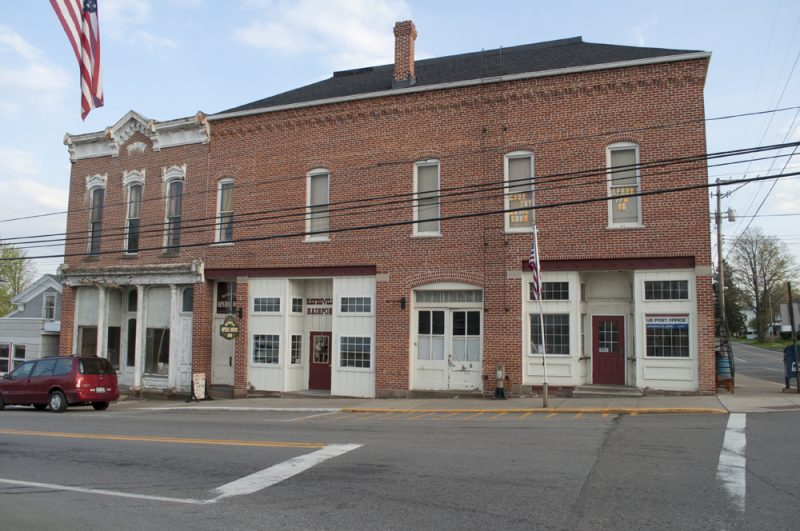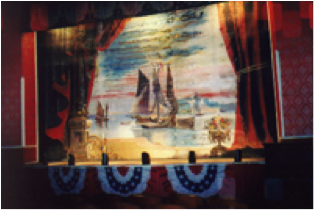Hayesville
 Current Name of Theater: Hayesville Opera House
Current Name of Theater: Hayesville Opera House
Current Type: Movies and live shows.
Seats: 200
Website: http://userpages.bright.net/~opera/hayesville/
Historic Names of Theater: Hayesville Opera House
Address: 5 1/2 East Main Street, Hayesville, Ohio 44838
Year Built: 1886
Original Architect: Samuel Craig
Original Cost: $4100.00
Listed on National Register: yes – 76001364

History of Theater:
Construction for the opera house began in 1885. On April 14, 1884 the citizens of Hayesville, Ohio approved its construction at a special election by a vote of
100 to 13. Total cost for the building at the time was $4852.20. Bids for the construction of the opera house were opened August 6, 1885. Local contractor, Samuel Craig was given the contract to build the opera house at a cost of $4100.00.
Work by Mr. Craig began October 1, 1885.
The two story brick building was completed on April 26, 1886 when the operetta “Genevieve” was presented on the opera house stage. Throughout the early years the opera house saw numerous performances. These included serving as the location of the annual Hayesville Memorial Day program where tribute to the veterans from the Hayesville area was given. At this same time the opera house was also used by the Vermillion Academy which was a local Hayesville high school to present both school plays as well as graduation ceremonies on its stage. Often Vaudeville shows which featured medicine men selling their wares could be found in the opera house as well. At the same time some of the first silent movies in this area were shown here in the opera house.
The Hayesville Opera House is the only theatre to be found on the Lincoln Highway. This national highway runs in front of the opera house. This road is also known as old route 30.
The Hayesville Opera House is an historic theater built in 1886 by the Village of Hayesville, Ohio. The theater occupies the second floor with retail space and the Mayors office on the first floor. Today the theater remains in original condition with four dressing rooms, raked (sloped) stage, 6 hand painted sceneries (dating from 1886) and 270 wooden theater seats. One of the unique aspects to this theater is the numerous signatures of performers found written on the stage walls. In 1976 the opera house building was listed on the National Register of Historic Places, this was the first building in Ashland County to receive this honor. In addition, this is the only opera house located on the Lincoln Highway, a national highway which went from the east to the west coast during the 1900’s.
The theater was used from 1886 to 1930 as the main cultural focus for the Village of Hayesville. Also held here were the graduation ceremonies for the local schools. After 1930 the theater fell into disuse and was left that way until about 1970. In that year a group of concerned citizens came together to begin the task of cleaning and updating the theater with new electrical wiring, wall paper and paint. This task was undertaken in preparation of the national bicentennial celebration in 1976. In about 1980 the opera house stage again went silent as interest in the original committee began to wane.
Cost of Rehabilitation: $200,000
Architect: October 1997 the architectural firm of Alexander and Associates from Mansfield
Contractors:
Source of Funds: State of Ohio – capital budget, Save America’s Treasure program in 2005, Ashland County Community Foundation and the Richland County Foundation.
Renovation Story
In 1994 interest was again expressed in finding a use for the old theater. During that time the Hayesville Opera House Restoration Board, Inc was formed. This group was charted by the state of Ohio, and their tax exempt status was also earned that year. The primary goal of this committee was to update the theater to meet the needs of today’s audience. The chief objective of this group was to make the theater handicapped accessible. This goal could be achieved by the installation of an elevator in a new addition to be built to the rear of the building. This method would be the least destructive means to follow in preserving the historic character of the room. At the same time this committee also serves as the managers for the theater by presenting movies, lectures, plays, and concerts on the opera house stage. In order to serve a wider based audience, the committee feels that this new addition is necessary.
Some of the architectural features found in the opera house today are original to the building. These include; the 200 seats with hat racks under the seats, hand painted backdrops, ticket board, and a small section of original wallpaper. The stage area contains four dressing rooms with the floor of the stage being slanted or “raked” to provide the audience with the best view to the actors. Also present but not used are the gas light fixtures back stage. Another hidden treasure of the opera house is the hundreds of signatures found on the walls back stage. During the early years actors often signed the walls for good luck. Many of these names date back to the 1890’s with the earliest being Buffalo Bill Cody who performed in the opera house in 1888.
In 1969 electricty was installed for the first time upstairs in the opera house.
In 2005 a grant from the National Park Service was used to restore the theatre back to its 1886 appearance. The work involved restored wooden seating, new paint and redecorating. The appearance of the opera today is how the theatre looked in 1886, when it first open.
Today the opera house is still owned by the Village of Hayesville.
![]()

